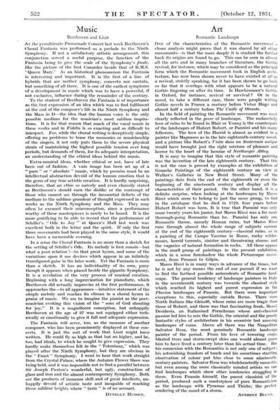Art
Romantic Landscape
ONE of the characteristics of the Romantic movement—. closer analysis might prove that it was shared by all other movements—is that the more deeplysit is studied the further back its origins are found to go. This-can be seen in almost all the arts and in many branches of literature, the Gothic revival, for instance, which may be considered as the principal form which the Romantic 'movement took in English archi_ tecture, has now been shown never to have existed at all as a revival, strictly speaking, for it has been shown to go back so far that it overlaps with what appears to be a natural Gothic lingering on after its time. Is Hawkesmoor's Gothic in Oxford, for instance, revival or survival ? Or in the novel, to take a different case, there were people writing Gothic novels in France a century before Victor Hugo and almost half a century before The Castle of Otranto.
In the field of painting the Romantic movement was most clearly reflected in the, genre of landscape. The melancholy love of ruins to be found in Blair or Young is the counterpart of the landscapes of Hubert Robert, or Parmini and his many followers. The love of the Horrid is almost as evident in a painter like Magnasco as in the late eighteenth-century novel, and a picture like Robert's Vi-site dans un Souterrain antique would have brought just the right mixture of pleasure and horror to the heart of the heroine of Northanger Abbey.
It is easy to imagine that this style of romantic painting was the invention of the late eighteenth century. That this is not the case is proved by examples at the exhibition of Gouache Paintings of the - eighteenth century on view at Walker's Galleries in New Bond Street. Many of the paintings date frau the end of the eighteenth or even the beginning of the nineteenth century and display all the characteristics of their period. On the other hand, it is a definite surprise, when looking at the landscapes by Marco Ricci which seem to belong to just the same group, to find in the catalogue that he died in 1729, four years before Hubert Robert was born. It is true that Pannini was only some twenty years his junior, but Marco Ricci was a far more thorough-going Romantic than he. Pannini has only one Romantic theme, namely Roman ruins, but Marco Ricci runs through almost the whole range of subjects current at the end of the eighteenth century—classical ruins, as in a painting of the Campo Vaccino in Rome, rocky wilder- nesses, horrid torrents, sinister and threatening storms and the vagaries of natural formation in rocks. All these appear in the small group of paintings in the present exhibition, which in a sense foreshadow the whole Picturesque move- ment, from Piranesi to Gilpin.
Marco Ricci is in many ways in advance of the times, but he is not by any means the end of our pursuit if we want to find the farthest possible antecedents of Romantic land- scape. The general tendency of landscape painters in Italy in the seventeenth century was towards the classical style which reached its highest and purest expression in the Photion landscapes of Poussin. But there were important exceptions to this, especially outside Rome. There were North Italians like Ghisolfi, whose ruins are more tragic than those of Robert, and there was that fascinating freak, Monsil Desiderio, an Italianized Frenchman whose anti-classical passion led him to mix the Gothic, the oriental and the purely fantastic styles of architecture in his eccentric but amusing landscapes of ruins. Above all there was the Neapolitan Salvator Rosa, the most genuinely Romantic landscape painter of the period. From his love of towering crags, blasted trees and storm-swept skies one would almost guess him to have lived a century later than his actual time. But his connexion with the Romantics is not only one of subject'; his astonishing freedom of touch and his sometimes startling observation of colour put him close to some nineteenth- century painters. Salvator Rosa was wholeheartedly romantic, but even among the more classically minded artists we can find landscapes which show other tendencies struggling in them. Even Poussin himself, the purest classicist of the period, produced such a masterpiece of- pure Romanticism as the landscape with Pyramus and Thisbe;' the perfect rendering of the mood of a storm. AwritoNY BLUNT.














































 Previous page
Previous page